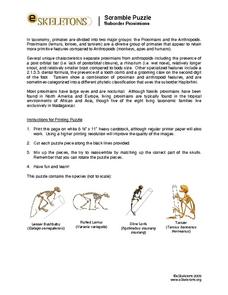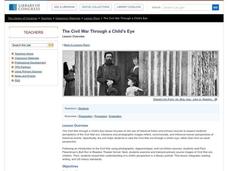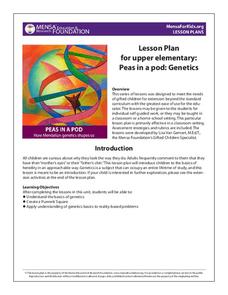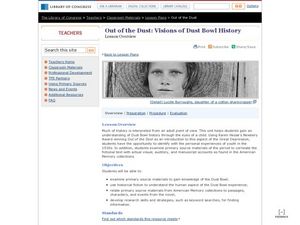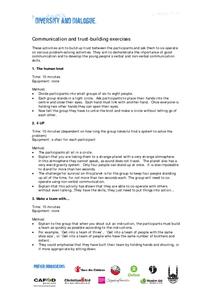eSkeletons
Skeleton Scramble Puzzle: Suborder Prosimians
Explore the finer details of primate skulls with these puzzles, incorporating advanced scientific analysis of two suborders- Prosimians and Anthropoidea- and one superfamily- Hominoidea. Learners read about the unique characteristics of...
National Mississippi River Museum & Aquarium
Sun Printing
Ozalid acid paper is sensitive to the light. It reacts by getting darker, and it's the same paper photographers use when they print their pictures. Here, kids get to use photo-sensitive paper to create sun prints to find out...
ReadWriteThink
Teaching Point of View With Two Bad Ants
What better way to explain the concept of point of view than from an ant's perspective! After reading Two Bad Ants, pupils identify the point of view of the ants by studying the text and pictures. Then, they fill out a...
Curated OER
Bugs-Eye View
Students research different bugs and insects and write letters from bugs' and insects' points of view to humankind.
Curated OER
Binaural Hearing in Humans
For this creative science activity from Scientific American, young scholars learn more about hearing with two ears and make a hands-on exploration of how sound is located. Excellent web link resources are also provided.
Curated OER
Body Parts in Spanish
Students use Spanish to recognize and recall body parts. For this Spanish anatomy lesson, students identify and name the parts of the body in Spanish. Students describe a person physically by his hair and color of eyes. Students graph...
Curated OER
The Civil War Through a Child's Eye
Students use primary and secondary sources to observe a child's view of the Civil war. In this Civil War lesson, students understand that different people had different perspectives on the war. Students recognize the...
NASA
NASA Visualization Explorer
Read some of the most up-to-date information available from NASA's current Earth and space research! Along with showcased stories, you will find computer animations and satellite images that help you to view what humans cannot see with...
Curated OER
Melba Pattillo and Ruby Bridges: Two Heroes of School Integration
Learners put themselves in the shoes of students who integrated Little Rock High School in 1957-58. Note: The primary resources in this activity provide powerful and poignant descriptions of what those students faced.
Scholastic
Study Jams! The Senses: Hearing
How does this sound? It's a rockin' video starring two teenage girls talking about music, hearing, and the ear. Listeners hear that the ear does not only gather sound waves, but also helps us maintain balance. They also will get an...
Smithsonian Institution
Watching Crystals Grow
Amazing science can sometimes happen right before your eyes! The class gets cozy as they watch crystals grow. They use Epsom salts, rocks, and food coloring to create crystals. They'll observe the entire process, documenting every step...
Curated OER
Bible (Day 7) Redemption and Caretakers
Whether you are religious or not, humans can be caretakers of the Earth. Students will discuss recycling, how their wasteful actions effect the Earth, and the Alaskan oil spill. They then have small group discussion and write about how...
Curated OER
Science Crossword Puzzle: The Body
The human body is the topic explored for this small crossword, there are seven questions at a relatively basic level.
Curated OER
Parts of the Body 2
In this spelling worksheet, students analyze the names of 20 body parts which have been scrambled. Students unscramble the words, putting the correct body part name on the line.
Curated OER
Parts of the Body 3
In this spelling instructional activity, students learn to spell parts of the body by first analyzing 20 names which have missing letters. Students add some letters to complete each word.
Curated OER
For Your Eyes Only
Learners identify two major types of visible pollutants, smog, and particulate matter, They explain that air pollutants are generated during incomplete combustion. They measure and rank collectors from the most pollutants to the least...
MENSA Education & Research Foundation
Peas in a Pod: Genetics
Can peas have grandparents? Learn about inherited traits and heredity with a set of activities focused on Mendelian genetics. As your class learns about the process of passing traits along in Punnett squares, they take on the role of...
Curated OER
People and the Environment
For this environment worksheet, students look at how different human actions can cause pollution and how the pollution effects the environment. This worksheet has 6 short answer questions.
Curated OER
Taste, Smell, Touch
Students explore the senses, taste, touch and smell. In this lesson about senses, students perform experiments, or activities. Students complete three activities in order to become more familiar with the three senses of taste, touch, and...
Curated OER
Out of the Dust: Visions of Dust Bowl History Lesson Overview
Students complete activities with the book Out of the Dust by Karen Hesse. In this literature lesson plan, students read this story and view the Dust Bowl history from the eyes of a child. They discover the Great Depression and life...
Curated OER
Insect Anatomy
Break down insect anatomy with this worksheet! Class members diagram insect anatomy by drawing a line from the names of grasshopper body parts to the corresponding parts on an image of a grasshopper. The worksheet provides the word bank...
Diversity and Dialogue
Communication and Trust-Building Exercises
Help learners build trust and develop verbal and non-verbal communication skills with a variety of interactive activities outlined in this resource.
Curated OER
Rainy Day? P.E. Anyway!
If your PE class is faced with bad weather and must stay indoors, try one of these activities to keep them engaged and moving! Activities involve working in teams, identifying sports or parts of the body, coordination practice, and/or...
Curated OER
Applied Science - Science and Math Lab
Students explore the senses. In this Applied Science lesson, students investigate the items in "feely" boxes with their hands, both touching the items and shaking the boxes to hear the sound the items make. Students also smell and taste...
